“In God We Trust.”
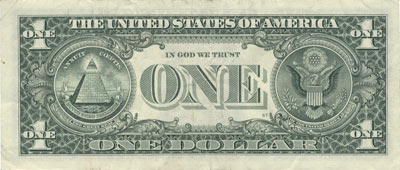
By 1966, the motto had been added to all of the nation’s paper money.
The current suit, filed in Ohio in January 2016 by atheist lawyer-activist Michael Newdow, argues that there is no “compelling government interest” in the motto and that placing it on coins and currency forces atheists to use forms of money to which they strongly object.
The case was still pending in late July 2016. In previous lawsuits, however, judges have consistently upheld the use of the motto on money.
A federal judge in New York, in a ruling Sept. 10, 2013, dismissed a lawsuit seeking to force removal of the words from U.S. coins and currency. In doing so, District Judge Harold Baer Jr. wrote that “the U.S. Supreme Court has repeatedly assumed the motto’s secular purpose and effect” and that federal appeals courts “have found no constitutional violation in the motto’s inclusion on currency.”
The suit had been filed Feb. 1 by an atheist group called the Freedom From Religion Foundation and 19 other plaintiffs. They demanded that the U.S. Treasury be ordered to remove the motto from U.S. coins and paper money on grounds that its use constitutes “discrimination” against non-believers.
By handing their money to anyone in a commercial exchange, the plaintiffs argued, atheists are “forced to proselytize – by an act of Congress – for a deity they don’t believe in.”
The judge ruled that while the plaintiffs might feel offended, they suffered no “substantial burden” because of the motto’s appearance on U.S. money.
A similar case in 2011, brought by the same atheist attorney, Michael Newdow, went all the way to the U.S. Supreme Court, where it was rejected.
Most Americans, including President Barack Obama, have taken the words “In God We Trust” for granted. Thus, many were surprised in 2011 when the House of Representatives voted to reaffirm this simple phrase as the official national motto.
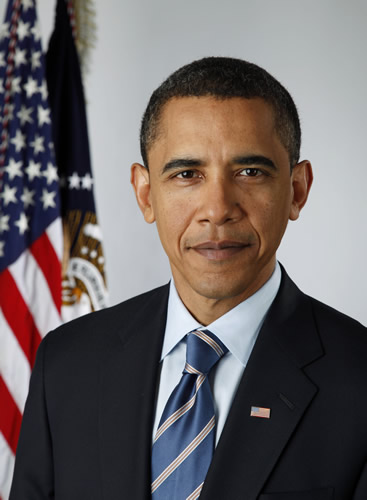
44th President Barack Obama
The story of the motto is an engrossing one, full of fascinating twists and
turns – and from its inception, the phrase has been closely linked to the money
in Americans’ pockets. The motto now appears on all U.S. coins and paper money,
but nearly a century passed before that point was reached. One coin lacked the
inscription as late as 1938 – and it didn’t appear at all on the nation’s paper
money until 1957.
The phrase “In God We Trust” made headlines in October 2011, when the House of
Representatives passed a non-binding resolution reaffirming its status as the
U.S. national motto. It did so after President Barack Obama mistakenly referred
to “E Pluribus Unum” as the nation’s official motto. That familiar phrase –
which in Latin means “Out of many, one” – has appeared on U.S. coinage for more
than two centuries, but enjoys no official status.
Democrats, including Obama, charged that in drafting and passing the resolution,
the Republican-controlled House was wasting time that could have been better
spent on hammering out a job-creation bill.
“That’s not putting people back to work,” Obama said. “I trust in God, but God
wants to see us help ourselves by putting people back to work. There’s work to
be done. There are workers ready to do it. The American people are behind this.”
Randy Forbes Resolution

Congressman Randy Forbes
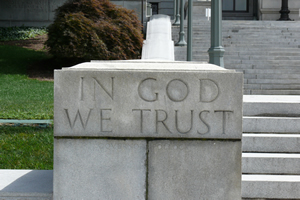
Pennsylvania State Capitol Entrance
E Pluribus Unum
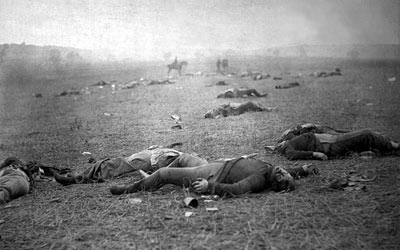
The Battle of Gettysburg was fought July 1–3, 1863
Many Americans mistakenly believe that the government’s use of the words “In God We Trust” dates back to the time of the Founding Fathers – as do two other familiar coinage inscriptions, “Liberty” and “E Pluribus Unum.” In point of fact, it was the Civil War, not the American Revolution, that gave rise to the phrase. The bitter, bloody War Between the States stoked religious fervor and led the Union government to seek solace and guidance from above.
Up to then, during more than seven decades of production, no U.S. coin had carried the motto, or anything resembling it. U.S. coinage had never made reference before that time to a supreme being – but the strong religious sentiments stirred by the Civil War created a climate conducive to the use of such an inscription.
A Baptist minister from Ridleyville, Pa., the Rev. Mark R. Watkinson, is credited with planting the seed for this unprecedented action. In a letter to Salmon P. Chase, President Abraham Lincoln’s Treasury Secretary, dated Nov. 13, 1861, Watkinson urged that provision be made for “the recognition of the Almighty God in some form on our coins.”
“This,” he said, “would relieve us from the ignominy of heathenism. This
would place us openly under the Divine protection we have personally claimed.”
Chase shared Watkinson’s view. And he soon set in motion steps that led to a
prominent reference to God on U.S. coinage. After receiving the minister’s
letter, he sent a note to Mint Director James Pollock stating: “The trust of our
people in God should be declared on our national coins. You will cause a device
to be prepared without unnecessary delay with a motto expressing in the fewest
tersest terms possible this national recognition.”
James Pollock was a former governor of Pennsylvania and an accomplished
congressman. He was raised in the Christian faith and had a strong belief in
God. He was a close friend of Abraham Lincoln with whom he had been active in
the anti-slavery movement.
Pollock apparently carried out this directive without delay. Though 1861 was
drawing to a close, he arranged for the striking of pattern half dollars and
eagles ($10 gold pieces) bearing that date. Patterns are coins produced by a
government mint to demonstrate something new – a new design, a new alloy or, as
in this instance, a new inscription. They carry a statement of value, but are
not legal tender because they were never monetized. And they’re frequently
struck in metals other than the ones used in regular coins of the same
denomination.
The pattern half dollars were identical in design to the Liberty Seated halves
then being issued for commerce – except for the addition of the motto “God Our
Trust” above the eagle on the reverse. In all, about three dozen of these were
made – some in silver and some in copper. The motto was placed on a scroll on
some of the coins, and written in small letters in the field above the eagle on
the rest.
The pattern $10 coins were struck in copper, rather than gold, some with bronzed
surfaces. Only 11 of these are known to survive; a single specimen in gold has
been reported but not confirmed. These had the same Liberty Head design as
regular $10 gold pieces of that time, but the words “God Our Trust” appeared in
the field above the eagle on the reverse.
Although there was no official reason for producing any more, similar pattern
half dollars and eagles were struck in somewhat higher quantities in both 1862
and 1863 – apparently to satisfy demand from numismatists who by then had become
aware of the earlier patterns’ existence.
There also are pattern silver dollars dated 1863 that are thought to have been
made at a later time, as well as some pattern halves seemingly struck in a
similar manner. Instead of “God Our Trust,” these bear the inscription “In God
We Trust” above the eagle. The Mint also produced a number of different patterns
in 1863 for a proposed bronze two-cent piece – and it soon became apparent that
such a coin, as a new denomination, would be a logical way to introduce an
inscription that also was new.
All forms of coinage vanished from circulation as the Civil War dragged on, largely because of speculative hoarding. The Union and Confederate governments both issued paper money, but this was widely distrusted and lost much of its value during the war – especially in the South, where Confederate notes eventually were used as wallpaper by many who found themselves holding the bags of worthless currency.
The Two-cent Piece
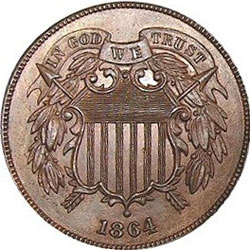
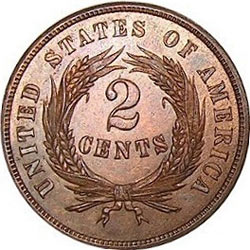
The motto “In God We Trust,” starting in 1864 on the 2 Cent Piece
There had never been a two-cent piece in the nation’s prior history, but the concept was not entirely new. Twice before, in 1806 and 1836, Congress had considered proposals for two-cent pieces made of billon – silver debased with a high percentage of copper. Both times, however, the plans had been rejected on the grounds that such coins would be easy to counterfeit.
That was not an issue in 1863, and the urgent need for coinage made a persuasive case for issuing such a coin on that occasion.
The mating of the two-cent piece with the motto “In God We Trust,” starting
in 1864, seems to have been a marriage of convenience. Secretary Chase had
been pondering the placement of some such wording on one or more of the
nation’s coins ever since receiving the Rev. Watkinson’s letter early in the
war, and production of patterns bearing possible mottos underscored the
importance he placed on this objective. The two-cent piece made a perfect
vehicle, for use of the motto there would cause no undue disruption or
confusion.
Initially, the Mint’s chief engraver, James Barton Longacre, fashioned two
pattern two-cent pieces carrying not only dissimilar designs but also
different inscriptions.
One of the patterns featured a right-facing portrait of George Washington on
the obverse, along with the words “God and Our Country” above the bust. The
other design – the one adopted – displayed a simple shield with crossed arrows
running through and beneath it; above this, a scroll proclaimed: “God Our
Trust.”
In each case, the reverse was dominated by the statement of value “2 Cents”
within a wreath of wheat, encircled by “United States of America.”
“God”-less Buffalo nickel
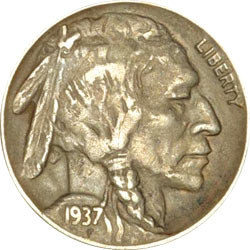
The famous 'God'-less Buffalo nickel
Congress enacted legislation in 1955 requiring the inscription on all U.S. coins
Exactly half a century before the motto “In God We Trust” first appeared on circulating U.S. coinage, a close approximation of this now-famous phrase turned up in a poem that went on to attain equally iconic status when it was set to music and became “The Star-Spangled Banner.” Few Americans are aware of this precursor, for the words are embedded in the seldom read – and almost never sung – fourth stanza of the poem, but it provides a fascinating link between their country’s official national motto adopted in 1956 and official national anthem adopted in 1931.
In the poem’s penultimate sentence, those who read – or sing – the entire set of lyrics will find the following reference to the Almighty:
Then conquer we must, when our cause is just,
And this be our motto: “In God is our trust.”
In his 1863 report to the Secretary of the Treasury, Pollock acknowledged the influence our National Hymn had on his work when he wrote:
“The motto suggested, “God our Trust, is taken from our National Hymn, the ‘Star-Spangled Banner.’ The sentiment is familiar to every citizen of our country; it has thrilled the hearts and fallen in song from the lips of millions of American Freemen. The time for the introduction of this or a similar motto, is propitious and appropriate. Tis an hour of National peril and danger, an hour when man’s strength is weakness, when our strength and our nation’s strength and salvation must be in the God of battles and of nations. Let us reverently acknowledge his sovereignty, and let our coinage declare our trust in God.”
A law passed by Congress in 1837 specified what devices and inscriptions could be used on U.S. coins. The Mint could make no changes without congressional approval, and it was with this in mind that Mint Director Pollock submitted the patterns for the new two-cent piece to Secretary Chase in December 1863. He proposed that when issued, the coin should bear one of two inscriptions: “Our Country, Our God” or “God, Our Trust.” Chase replied as follows:
“I approve your mottoes, only suggesting that on that with the Washington obverse the motto should begin with the word ‘Our,’ so as to read ‘Our God and Our Country.’ And on that with the shield, it should be changed so as to read: ‘In God We Trust.’ ”
Whatever the explanation following more communication between Chase and Pollock, “In God We Trust” was chosen – and after nearly 150 years on the nation’s coinage, it now seems as basic to the American way of life as singing “The Star-Spangled Banner” or reciting the official Pledge of Allegiance.
A third pattern two-cent piece dated 1863 bears the adopted motto, “In God We Trust.” But this was created in the 1870s, at the end of the coin’s brief life. Its production might be attributable to collector demand for such a coin after the Congress discontinued the two-cent piece in 1873.
Over the years, the motto was added progressively to other U.S. coins; it has appeared on every denomination since 1938, when the “God”-less Buffalo nickel was retired.
Throughout its history, some have made light of the motto with the offhanded quip, “In God We Trust – All Others Pay Cash.” Today, with the dollar so weak, many see a kernel of reality in that quip.
Use of “In God We Trust” wasn’t required by Congress when it passed legislation authorizing the two-cent piece on April 22, 1864. The law simply gave the Treasury discretionary authority regarding the inscriptions on the nation’s minor coins. The Mint chose not to add “In God We Trust” to the new bronze Indian Head cent.
The authority was extended to gold and silver coins on March 3, 1865 – and, for the first time,
“In God We Trust” was specifically mentioned in that follow-up legislation. The motto’s use wasn’t mandated, though, until 1908
– and even then, the order applied only to gold and silver coins. It wasn’t until 1955 that Congress enacted legislation requiring the inscription on all U.S. coins. By then, it was already there.
“In God we trust” on all coinage
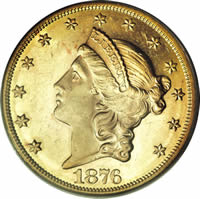
1876 Liberty Double Eagle Type II
Type II $20 Liberty Double Eagles were minted only between 1866 and 1876
In 1866, the motto was added to the silver dollar, half dollar, quarter dollar and $20, $10 and $5 gold pieces (double eagle, eagle and half eagle). It also was used on the Shield nickel, which made its debut that year, and remained throughout the run of that coin – but then was omitted from both the Liberty Head and Buffalo nickels, finally reappearing on the five-cent piece when the Jefferson nickel was introduced in 1938. It wasn’t used on the dime until 1916.
It never appeared on the gold dollar and $3 gold piece, and wasn’t added to the $2½ gold piece (quarter eagle) until 1908.
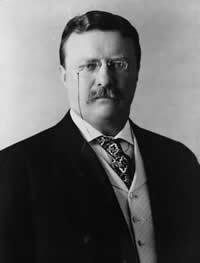
26th President Theodore Roosevelt
Roosevelt objected to the use of 'In God We Trust' on the nation's money as blasphemous
In 1908, a law required that the words appear on U.S. coins, though the cent, nickel and dime were exempted because of their size. The Lincoln cent and Winged Liberty (“Mercury”) dime both carried the motto when they debuted in 1909 and 1916, respectively, even though its use on those coins was optional. But the phrase wasn’t added to the nickel until 1938, at which point all U.S. coins carried the motto. All have done so ever since.
The 1908 law resulted directly from a typically impulsive decision by
President Theodore Roosevelt. It was Roosevelt who triggered a revolution in
U.S. coinage art in the early 20th century, and his interest in coins extended
not only to their artistry but also to the inscriptions they carried. He
objected to the use of “In God We Trust” on the nation’s money as blasphemous
and argued that it cheapened the motto, because the coins could be used for
illegal and immoral purposes in less than pious environments.
Public Law 140
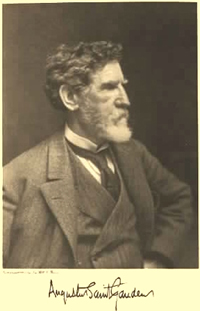
Augustus Saint-Gaudens
Nearly half a century passed after that before the inscription was added to U.S. paper money. In 1955, President Dwight D. Eisenhower signed a law requiring the motto on all U.S. paper money as well as all coinage. The phrase was added to paper currency in increments from 1957 to 1966. In 1956, the phrase was adopted as the United States’ official national motto.
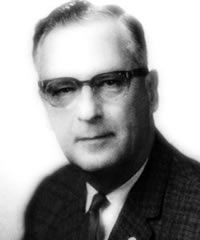
Matthew H. Rothert Sr
It was Rothert’s belief that “a message about the country’s faith in God
could be easily carried throughout the world if it were on United States
paper currency.”
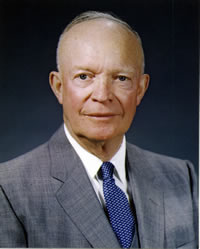
34th President Dwight D. Eisenhower
Public Law 140, requiring use of the motto on U.S. paper money, was introduced in the 84th Congress and signed into law by President Eisenhower on July 11, 1955. A year later, on July 30, 1956, Eisenhower signed a second bill establishing “In God We Trust” as the national motto. And one year after that, in October 1957, new $1 bills carrying the inscription became the first to enter circulation. By 1966, the words had been added to all of the nation’s paper money.
50th Anniversary of Our National Motto
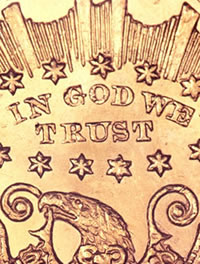
'In God We Trust' now appear on all coinage.
The inclusion of 'In God We Trust' on U.S. coins and paper money has also been a point of contention with various segments of the American society.
On July 30, 2006, the 50th anniversary of the 1956 bill recognizing the status of “In God We Trust” as the national motto, President George W. Bush issued a proclamation reaffirming the appropriateness of this designation.
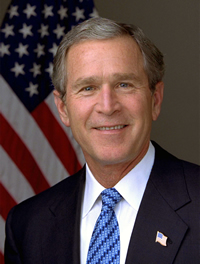
43rd President George W. Bush
President George W. Bush on July 30, 2006 issued a proclamation reaffirming the appropriateness of “In God We Trust” as the national motto.
“Today,” Bush said, “our country stands strong as a beacon of religious freedom. Our citizens, whatever their faith or background, worship freely and millions answer the universal call to love their neighbor and serve a cause greater than self.
“As we commemorate the 50th anniversary of our national motto and remember with thanksgiving God’s mercies throughout our history, we recognize a divine plan that stands above all human plans and continue to seek His will.”
Not long after that, God-fearing Americans began noticing the apparent absence of the inscription on the presidential $1 coins, which made their first appearance in March 2007. In truth, the motto was there – but it had been moved, along with other inscriptions, to the edge of the coins to make room for more artistic designs on the two main surfaces.
Atheist Cents
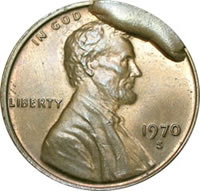
The Atheist Cent
“Who calls a shot like that? Who makes a decision like that?” she asked rhetorically. “It’s a disturbing trend.”
It was widely believed that Palin assumed the “omission” had been made by the Obama Administration. But, in fact, the placement of the motto on the edge of the presidential dollars had been determined while George Bush was president.
Soon thereafter, the inscription was moved to a much more prominent location on the obverse of the coins.
Some presidential dollars have indeed been “God-less” because they were struck by error with plain edges. Ironically, these coins enjoy substantial premiums over normal examples.

Sarah Palin
First Republican woman nominated for the vice-presidency.
These mint error coins came to be known as “atheist cents” and stirred considerable interest at the time. They’re not great rarities, but they’re scarce enough to be worth a modest premium even now.
The inclusion of “In God We Trust” on U.S. coins and paper money has long
been a point of contention with certain segments of the American populace.
It has been challenged in court a number of times as a violation of the
Establishment Clause of the U.S. Constitution’s First Amendment and of the
principle of separation of church and state.
Critics charge that the phrase constitutes “respect for an establishment of
religion” by the government. However, appeals courts have consistently held
that such traditional, patriotic or ceremonial words do not amount to
government sponsorship of a religious exercise or the establishment of a
religion.
In all of these respects, it has been an important – and now indispensable – thread in the fabric of America’s national life.
Tell the Other Side of Our National Motto's story
By Mike Fuljenz
Like every coin, every story has two sides. Coin World gave short shrift to one of those sides in a front-page news story about a federal lawsuit seeking the removal of the words “In God We Trust” from U.S. coins and currency.
The Coin World article focused on atheist attorney Michael Newdow’s claims, but it also included comments by atheist blogger Hemant Mehta, which do not appear in the suit. And it noted Mark Twain’s reservations about the motto’s appropriateness on coins, which the lawsuit never mentions..
Amid all the details on the atheists’ side of the story, there isn’t a quote from anyone holding contrary views. (Even Newdow acknowledged in the lawsuit that the American Numismatic Association, in a mid-1950s resolution, supported placing “In God We Trust” on currency.)
Texas Attorney General Ken Paxton was asked to render a legal opinion about a plan to display “In God We Trust” on police cars in one Texas town. He responded this way: “A court is likely to conclude that a law enforcement department’s display of the national motto, ‘In God We Trust,’ on its patrol vehicles is permissible under the Establishment Clause of the United States Constitution.”
Paxton noted that courts have consistently rejected similar suits in other contexts – including several by Newdow – on grounds that the motto’s use was “of a patriotic or ceremonial character.”
The U.S. Supreme Court recently upheld the right of a municipality to open its town meetings with prayer. Paxton pointed out that displaying “In God We Trust” on police cars was a similar “passive use” that wouldn’t restrict dissenters’ rights or force them to accept a view they didn’t share.
Coin World’s story said nothing about the inaccurate historical claims made by Newdow in the published interview also referenced.
Newdow said: “There is obviously no compelling government interest in having ‘In God We Trust’ on our money. We did fine for the 75 years before the phrase was ever used at all, and continued to do fine for the subsequent 102 years before such inscriptions were made mandatory on every coin and currency bill.”
Although “In God We Trust” didn’t appear on U.S. coinage until 1864, an almost identical phrase was used by Francis Scott Key 50 years earlier in “The Star-Spangled Banner,” which became our only official National Anthem in 1931. In the fourth stanza, those who read the lyrics will find the words that inspired the motto’s use on America’s money:
Then conquer we must, when our cause is just,
And this be our motto: “In God is our trust.”
“The Star-Spangled Banner” was clearly well known to millions of Americans during that half-century.
Mint Director James Pollock wrote in 1863 that the coinage motto “is taken from our National Hymn, the ‘Star Spangled Banner.’ The sentiment is familiar to every citizen of our country; it has thrilled the hearts and fallen in song from the lips of millions of American Freemen.”
Further disproving Newdow’s claim is the fact that since 1765, the official motto of his alma mater, Brown University, has been In Deo Speramus, a Latin phrase meaning “In God We Hope.” Surely Newdow, who told Brown’s alumni magazine in 2004 that “I was born an atheist,” was well aware of this previous expression of the same Godly sentiment in almost the very same words.
And Newdow is just as inaccurate with numbers: The timespan between 1864 and 1955, when the motto became mandatory on all U.S. currency, covered 91 years, not 102.
Newdow’s timeline is further muddied by the fact that all U.S. coins have carried the motto since 1938.
I also find it puzzling that Newdow chose to file this latest suit in Coin World’s home state, Ohio, whose official motto since 1959 has been “With God All Things Are Possible.” This motto was upheld by a 9-4 vote of the full 6th Circuit Court of Appeals.
I’m a strong believer in tolerance toward people who don’t share my views. But let’s be sure to tell both sides of every story.
###